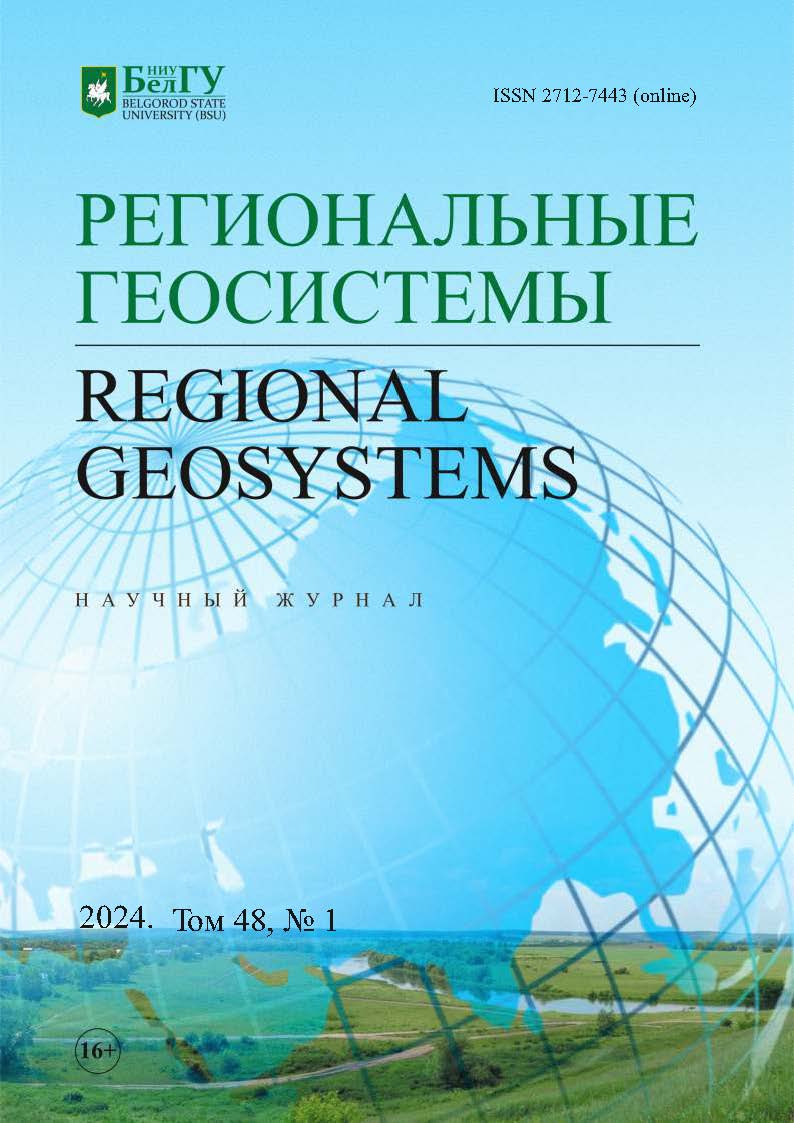Correlation of Grain Crop Yield and Vegetation Index SAVI on Territory of the Republic of Tatarstan
DOI:
https://doi.org/10.52575/2712-7443-2024-48-1-91-105Keywords:
Earth remote sensing, photogrammetry, geoinformation technologies, multispectral analysis, vegetation index, correlation and regression analysis, grain crop yieldAbstract
The article considers the possibilities of using Earth remote sensing data and geoinformation technologies to analyze and predict the yield of grain crops grown in different soil zones of the Republic of Tatarstan. The key factors influencing the growth and development of plants in soil and climatic conditions of the region are identified. The results of geodata processing from Landsat-8 satellite images using spectral analysis methods, which allowed to calculate the values of vegetation indices for grain crops, are presented. The results of correlation-regression analysis of 2021 data led to the detection of a high degree of correlation closeness (r = 0.8) between SAVI index and average grain yield for a given sample of municipal districts representing all soil zones of the region. This dependence reflects non-linear relations between the indicators. The dynamics of SAVI index values during vegetation phase is characterized on the basis of time series trend analysis. It is shown that high average daily temperatures, contributing to the inhibition of plant growth and development, are reliably reflected by low values of the SAVI index for the region. The conclusion about the inverse relationship between vegetation index SAVI and water index in grain crops fields of the region is given.
Downloads
References
Архив погоды: Татарстан. Погода и климат. Электронный ресурс. URL: http://www.pogodaiklimat.ru/archive.php?id=ru®ion=16 (дата обращения 07.04.2023).
География Татарстана. 1994. Казань, Магариф, 142 c.
Кусова Н.В. 2017. Развитие зернового хозяйства. Орел, Орловская областная научная универсальная публичная библиотека им. И.А. Бунина, 36 с.
Министерство сельского хозяйства и продовольствия Республики Татарстан. Правительство РТ. Электронный ресурс. URL: https://agro.tatarstan.ru/ (дата обращения 17.02.2023).
Сулейманова Г.В. 2014. География Республики Татарстан. Казань, Казанский национальный исследовательский технологический университет, 322 с.
Учебное пособие QGIS. QGIS documentation. Электронный ресурс. URL: https://docs.qgis.org/3.28/ru/docs/training_manual (дата обращения 12.04.2023).
Earth Explorer. USGS. Electronic resource. URL: http://earthexplorer.com/ (date of the application 08.04.2023).
Index: Transformed NDVI. Electronic resource. URL: https://www.indexdatabase.de/db/i-single.php?id=202 (date of the application 20.10.2023).
Белоусова А.П. 2019. Применение вегетационных индексов при анализе использования пахотных угодий (на примере Уинского района Пермского края). Вестник Сибирского государственного университета геосистем и технологий, 24(4): 208–218. https://doi.org/10.33764/2411-1759-2019-24-4-208-218.
Береза О.В., Страшная А.И., Лупян Е.А. 2015. О возможности прогнозирования урожайности озимой пшеницы в Среднем Поволжье на основе комплексирования наземных и спутниковых данных. Современные проблемы дистанционного зондирования Земли из космоса, 12(1): 18–30.
Долина К.В. 2023. Применение геоинформационных технологий и данных дистанционного зондирования Земли для выявления особенностей роста и развития сельскохозяйственных культур в различных почвенно-климатических условиях на территории Республики Татарстан. Магистерская диссертация по направлению 05.04.03 «Картография и геоинформатика. Казань, КФУ, 97 с.
Ерошенко Ф.В. 2017. Оценка качества зерна озимой пшеницы в Ставропольском крае по данным дистанционного зондирования Земли. Бюллетень Ставропольского научно-исследовательского института сельского хозяйства, 9: 118–128.
Коротков А.А., Астапов А.Ю. 2020. Вегетационный индекс NDVI для мониторинга растительности. Наука и образование, 3(3): 131–140.
Раджабова Р.Т., Алексеенко Н.А., Курамагомедов Б.М., Тажудинова З.Ш., Султанов З.М. 2020. Использование индексных изображений при дешифрировании растительного покрова Внутригорного Дагестана. Юг России: экология, развитие, 15(4(57)): 126–136. https://doi.org/10.18470/1992-1098-2020-4-126-136.
Сабирзянов А.М. 2008. Формирование урожая яровой пшеницы в зависимости от использования факторов химизации в условиях Предкамья Республики Татарстан. Автореф. дис. ... канд. сельскохоз. наук. Казань, 20 с.
Сабирзянов А.М. 2015. Применение дистанционного зондирования для прогнозирования урожайности сельскохозяйственных культур (на примере Нурлатского муниципального района Республики Татарстан). Землеустройство, кадастр и мониторинг земель,
(124): 36–39.
Трошко К.А., Денисов П.В., Лупян Е.А., Плотников Д.Е., Толпин В.А. 2021. Особенности состояния зерновых культур в регионах европейской части России и Сибири в июне 2021 г. по данным дистанционного мониторинга. Современные проблемы дистанционного зондирования Земли из космоса, 18(3): 325–331. https://doi.org/10.21046/2070-7401-2021-18-3-325-331.
Bannari A., Morin D., Bonn F., Huete A.R. 1996. A Review of Vegetation Indices. Remote Sensing Reviews, 13(1–2): 90–120. https://doi.org/10.1080/02757259509532298.
Henrich V., Götze E., Jung A., Sandow C., Thürkow D., Gläßer C. 2009. Development of an Online Indices Database: Motivation, Concept and Implementation. In: Proceedings of the 6th EARSeL Imaging Spectroscopy Sig Workshop Innovative Tool for Scientific and Commercial Environment Applications. Israel, Tel Aviv: 16–18.
Huete A.R. 1988. A Soil-Adjusted Vegetation Index (SAVI). Remote Sensing of Environment,
(3): 295–309. https://doi.org/10.1016/0034-4257(88)90106-X.
Abstract views: 176
Share
Published
How to Cite
Issue
Section
Copyright (c) 2024 Regional Geosystems

This work is licensed under a Creative Commons Attribution 4.0 International License.


